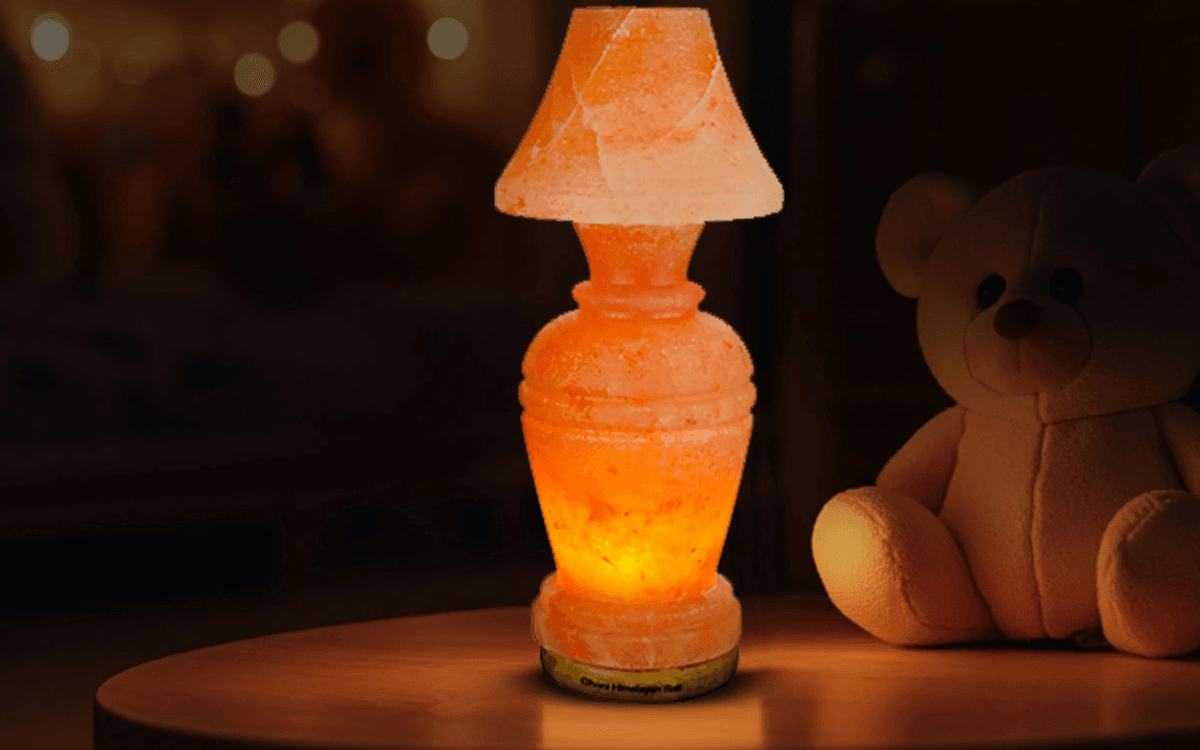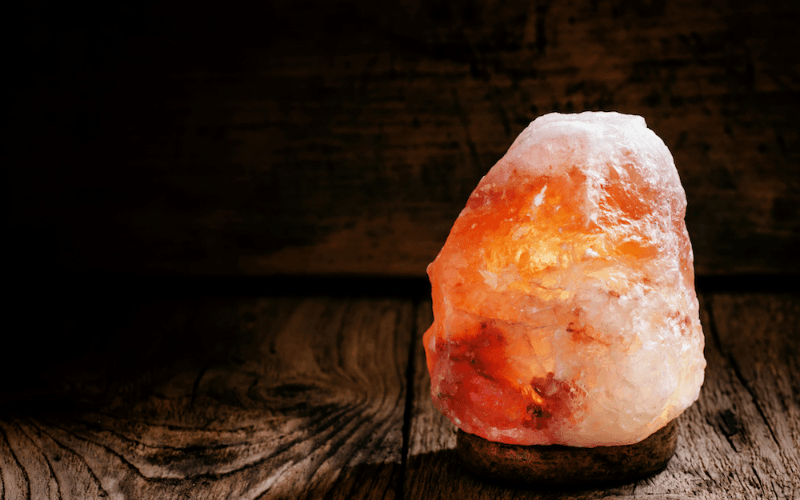In our modern world, the search for a good night’s sleep can feel endless. Surrounded by the sleep-disrupting blue glow of screens, many of us are looking for natural, gentle ways to unwind. This search has led to a surge in popularity for the Himalayan salt lamp, a beautiful crystal that promises not just a warm aesthetic, but a host of incredible health benefits.
Proponents claim it can purify the air, ease allergies, boost your mood, and most importantly, help you get to sleep. But are these claims rooted in reality or just clever marketing?
This guide separates the scientific fact from the wellness fiction. We will dive deep into the evidence, debunk the common myths, and uncover the real, science-backed ways a Himalayan salt lamp can be a powerful addition to your sleep routine. Let’s find out if this glowing gem is the secret to the restful night you’ve been dreaming of.
The Alluring Claims: What Are Salt Lamps Supposed to Do?
The popularity of Himalayan salt lamps is built on a foundation of impressive health and wellness claims. Before we examine the science, it’s important to understand what advocates believe these lamps can do.

Here are the most common purported benefits:
- Helps you get to sleep: The primary claim is that the lamp’s unique properties create the perfect environment for deeper, more restorative sleep, potentially helping with insomnia or irregular sleep patterns.
- Improve air quality & Relieve allergies: A central belief is that salt lamps act as natural air purifiers. They are said to remove dust, pollen, and pet dander from the air, offering relief for allergy sufferers.
- Improve mood & Increase energy: Many believe the lamps can lift spirits, increase energy levels, and even help treat conditions like Seasonal Affective Disorder (SAD).
- Minimise colds & Ease coughing and respiratory issues: By “cleaning” the air, they are often recommended for those with asthma or frequent colds to help clear airways.
- Create a warm aesthetic & Environmentally-friendly: Beyond health, they are loved for the cozy, serene ambiance they create and are often seen as an eco-friendly lighting choice.
The Science of Sleep: Debunking the Core Myths
While the list of benefits is certainly compelling, a closer look at the scientific evidence reveals that the core theories behind these claims are largely unsubstantiated. Let’s critically examine the two biggest myths.
1: Salt Lamps Are Powerful Negative Ion Generators
The most widespread theory is that salt lamps work by releasing beneficial negative ions. The idea is that as the bulb heats the salt crystal, it attracts and then evaporates water molecules, supposedly releasing a flood of negative ions that purify the air and boost mood.
The Reality: This theory doesn’t hold up to scientific scrutiny.
From a chemical perspective, the salt crystal (sodium chloride, or NaCl) is incredibly stable. According to retired American Chemical Society chemist John Malin, you would need to heat salt to about 1,500°F (815°C) to break its ionic bonds and release a significant number of ions. The low-wattage bulb in a salt lamp barely warms the surface and cannot come close to generating this level of energy.
Independent tests confirm this. One study found that a typical salt lamp’s negative ion emissions were so low they were “barely measurable.” Dr. Andrew Weil, a renowned leader in integrative medicine, states plainly, “There is no scientific support for such claims related to Himalayan salt lamps”.
2: Salt Lamps Effectively Purify the Air
The second major claim is that salt lamps cleanse the air through a process called hygroscopy—attracting and absorbing water molecules along with any dust or pollen they carry.
The Reality: While salt is indeed hygroscopic (which is why your lamp might “sweat” in humid rooms), there is no evidence this process meaningfully purifies the air.
Any pollutants that land on the lamp do so by chance, not because the lamp is actively drawing them in. As WebMD points out, even if the lamp did trap some contaminants, its small surface area would quickly become coated and ineffective.
For those genuinely concerned about indoor air quality, medical experts at the Cleveland Clinic recommend proven technologies like air purifiers with High-Efficiency Particulate Air (HEPA) filters, which are specifically designed to capture airborne particles.

| Myth vs. Reality: Himalayan Salt Lamp Claims |
| The Claim |
| Generates Negative Ions |
| Purifies the Air |
| Reduces EM Radiation |
So, How CAN a Salt Lamp Help You Sleep? The Real Mechanisms
After debunking the myths, you might be wondering why so many people swear by their salt lamps for better sleep. The answer isn’t in pseudoscience, but in two well-established principles: the effect of light on our brain and the power of a calming ritual.
1: The Psychology of Warm, Dim Light
The most significant and scientifically plausible way a Himalayan salt lamp can help you sleep is through the color of the light it emits.
Our bodies are flooded with bright, blue-wavelength light all day, especially from our smartphones, TVs, and computers. Evening exposure to this blue light is particularly harmful, as it suppresses the brain’s production of melatonin—the key hormone that regulates our sleep-wake cycle. When melatonin is suppressed, it’s much harder to fall and stay asleep.
Himalayan salt lamps, however, emit a soft, warm glow in the amber, orange, and red parts of the light spectrum. This low-color-temperature light is similar to a natural sunset, which is an evolutionary cue to our brains that the day is ending and it’s time to prepare for rest.
Crucially, this warm light does not interfere with melatonin production. By using a salt lamp as your primary light source for an hour or two before bed, you create a light environment that supports, rather than disrupts, your body’s natural transition into a restful state.
2: Creating a Relaxing Atmosphere and Ritual
The second real benefit is the calming ambiance a salt lamp creates. Its gentle, ambient glow fosters a cozy, tranquil atmosphere that can help lower stress and anxiety, which are two of the biggest enemies of good sleep.
This ties directly into the power of a pre-sleep ritual. The simple act of turning on your lamp each evening can become a powerful psychological cue. It signals to your body and mind that the day’s tasks are complete, the stress is over, and it’s now time to relax and unwind.
This is related to the placebo effect—a well-documented phenomenon where a person’s belief in a treatment can trigger a real physiological response. If you believe your lamp is calming, that expectation alone can help your body release relaxing hormones. This isn’t a trick; it’s a demonstration of the profound connection between your mind and body.
By making the lamp part of a larger routine—like reading a book, sipping herbal tea, or meditating—you amplify its power as a trigger for relaxation. It becomes a beautiful centerpiece for a sleep-friendly sanctuary. In fact, creating a truly serene space often involves more than just lighting; considering how you choose furniture for a guest room or your own bedroom plays a vital role in crafting that perfect, sleep-conducive environment.
A Practical Guide to Using and Buying a Himalayan Salt Lamp
While the main benefits are psychological, it’s crucial to understand the practical aspects of safety and authenticity. Many of the risks associated with salt lamps come from low-quality fakes.
Is It Safe to Leave a Salt Lamp on All Night?
The biggest safety concern is the risk of fire from faulty electrical components. In 2017, the U.S. Consumer Product Safety Commission (CPSC) recalled thousands of lamps because their dimmer switches were prone to overheating and igniting.
To ensure your lamp is safe, you must buy one whose electrical components have been certified by a reputable safety organization. In the US and Canada, look for a UL (Underwriters Laboratories) certification mark on the cord, plug, and bulb socket. This mark means the product has passed rigorous safety tests.
A genuine, UL-certified lamp is generally considered safe to leave on overnight. Always place it on a stable surface, away from flammable items like curtains, and out of reach of children and pets.
A Warning for Pet Owners
Himalayan salt is highly toxic to pets, especially cats and dogs. Cats, in particular, may be drawn to lick the salt, which can quickly lead to salt poisoning.
Symptoms include vomiting, diarrhea, lethargy, and seizures. In severe cases, it can be fatal. Because of this serious risk, you must place your salt lamp in a location that is completely inaccessible to any household pets.
How to Spot a Real vs. Fake Himalayan Salt Lamp
Ensuring you buy an authentic lamp is key for both safety and aesthetics. Here’s how to tell a real one from a fake:
- Country of Origin: Genuine Himalayan salt is mined from the Khewra Salt Mine in Pakistan. Lamps made elsewhere are likely not authentic.
- Glow and Brightness: A real lamp emits a soft, warm, and often uneven glow. If a lamp is bright enough to light up a whole room, it’s probably a fake made of a different crystal.
- Durability: Real salt is somewhat fragile and can chip. A lamp that seems unusually hard or shatter-resistant is suspicious. The surface should feel slightly rough, not perfectly polished.
- Moisture Absorption: A real lamp is hygroscopic and may “sweat” or feel damp in humid air. A lamp that stays bone dry is likely fake.
- Price and Policy: Be wary of rock-bottom prices, as authentic lamps are hand-carved. A reputable seller should also have a good return policy.
Care and Maintenance: Dealing with a “Leaking” Lamp
If you notice your lamp “leaking” or “sweating,” don’t worry—this is a normal sign of its authenticity. To manage it, keep the lamp turned on for a few hours each day. The bulb’s warmth will evaporate the moisture.
Avoid placing it in very humid areas like bathrooms. Most importantly, always place a coaster or protective mat underneath it to prevent moisture from damaging your furniture.
Conclusion
While the fantastic claims of air purification and ion generation are scientifically unfounded, the Himalayan salt lamp is far from useless. Its enduring appeal lies in its ability to solve a very real modern problem: creating a peaceful environment conducive to sleep.
The true, evidence-supported benefit of a salt lamp comes from its light. Its warm, amber glow is a beautiful and functional tool that helps you avoid sleep-disrupting blue light, allowing your brain to produce the melatonin it needs for a restful night.
Furthermore, its serene presence serves as the perfect centerpiece for a calming pre-sleep ritual, psychologically signaling to your body that it’s time to unwind.
If you view it not as a magical cure-all, but as a beautiful piece of functional decor to enhance your sleep hygiene, a genuine, safety-certified Himalayan salt lamp can be an invaluable ally. At Drift Beds, we know that quality sleep is foundational to wellness, and creating a tranquil sanctuary is the first step toward a more peaceful night’s rest.
FAQ: Your Himalayan Salt Lamp Questions Answered
Is it OK to leave a salt lamp on all night?
Yes, it is generally safe, but only if the lamp is authentic and its electrical components are UL-certified. You must also place it on a stable surface away from any flammable materials and out of reach of pets and children.
Do salt lamps really help with anxiety?
There is no scientific proof that salt lamps treat anxiety by emitting negative ions. However, their soft, warm glow creates a calming and relaxing atmosphere that can help reduce feelings of stress and promote a sense of well-being as part of a wind-down routine.
Do salt lamps really purify the air?
No, there is no credible evidence that they are effective air purifiers. While they do attract some moisture from the air (hygroscopy), this process does not remove a significant amount of airborne allergens, dust, or pollutants.
Why is my salt lamp leaking water?
This “leaking” is a normal process called hygroscopy. The salt crystal naturally attracts water molecules from the air, especially in humid environments. Keeping the lamp turned on will use the bulb’s heat to help evaporate this moisture. Always place it on a protective mat.
Are salt lamps dangerous for cats and dogs?
Yes, they can be extremely dangerous. If a pet licks the lamp excessively, it can suffer from salt poisoning, which is a serious and potentially fatal medical emergency. It is critical to keep salt lamps completely out of the reach of all pets.
What is the spiritual benefit of a salt lamp?
Many people feel that Himalayan salt lamps have spiritual properties, such as cleansing a space of negative energy, helping to balance chakras, or enhancing meditation and mindfulness practices. These are deeply held spiritual beliefs and are not based on scientific evidence.
